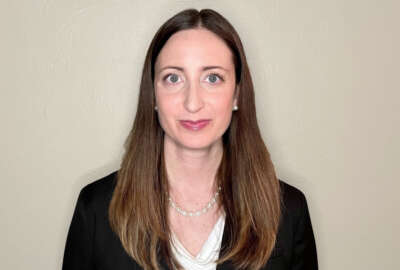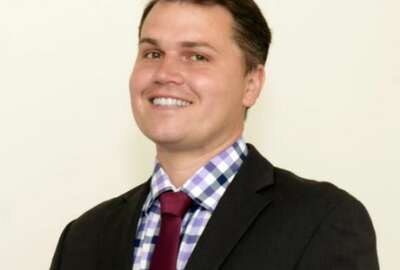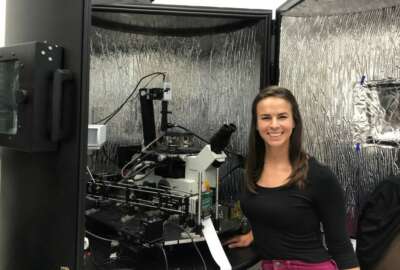This Air Force civilian engineer is the brainpower behind an exciting new weather satellite
The Air Force is hard at work on a project to replace its crucial weather satellites. Shepherding this project is a finalist in this year's Service to America...
Best listening experience is on Chrome, Firefox or Safari. Subscribe to Federal Drive’s daily audio interviews on Apple Podcasts or PodcastOne.
The Air Force is hard at work on a project to replace its crucial weather satellites. A billion dollar, low-earth orbit baby is expected to launch in 2023. It will bring all sorts of new capabilities in weather data gathering. My next guest has been shepherding this project, and is a finalist in this year’s Service to America Medals program. Federal Drive with Tom Temin welcomed Air Force systems engineer Chong Le.
Interview transcript:
Tom Temin: Mr. Lee, good to have you on.
Chong Le: Thank you. Thank you for having me here today Tom.
Tom Temin: Tell us about this project. What does it look like? What is the orbit going to be? What’s the timetable? Give us the background here.
Chong Le: Okay, the way the satellite project that our organization is developing it’s called Weather System Follow-on Microwave, also known as WSF-M. The satellite is being designed and built for the US Space Force by the Ball Aerospace Corporation. Now this satellite is flying at a nominal altitude of about 100 kilometer in a synchronous orbit, and scheduled for launch as you say in late 2023. Now in this orbit that the satellite is flying in general, you will see the satellite rising over you at around 6 to 6:15 am in the morning, and then settling behind you at around 6 pm in the evening, every day. This is important as we need to gather the weather data globally every day. So the WSF-M is one of many environmental sensing satellites that include the US Space Force meteorology satellite a program, which we are trying to replace them. The NOAA polar orbit environmental satellite, as well as other weather satellites, flying from other international property from around the world. So the ocean wind speed and direction that the WSF-M weather satellite is going to gather, we will provide all our US arm forces and meteorologists for tracking the storms, including the hurricane forecast, that kind of thing.
Tom Temin: And is this going to be one of several similar satellites eventually that will go maybe crisscross and get better coverage?
Chong Le: It will be one of the satellites working with other satellites to ingest the data into the model to do the forecast. You’re right. Absolutely.
Tom Temin: And so the first one then, the first of a new generation you might say, what can it do that the existing satellite that it replaces cannot do or what does it improve on?
Chong Le: WSF-M continues with the legacy of the DoD Microwave Mission, but we are taking the advantage of the new technology provided by our contractor, here it’s the Ball Aerospace. Let’s say compared to the DMSP satellite, the current DoD DMSP satellite cannot provide the ocean surface wind directions. The weather instrument on the WSF-M satellite will add new technology, new digital receivers, that will provide both the wind speed and the direction of the ocean surface. And also with the large antenna, which we also call it a reflector, a main reflector, WSF-M will provide the higher resolution imagery so you can see the storm structured clearer than the older system can provide.
Tom Temin: Yeah, I guess wind direction is kind of important thing to know, along with speed
Chong Le: Correct. That’s one of the DoD environmental monitor gap that we are trying to provide.
Tom Temin: We’re speaking with Chong Le, Air Force systems engineer and also a finalist in this year’s Service to America metals program. So, the resulting capabilities then come from new instruments that are aboard is there also something new about the satellite itself the platform
Chong Le: Yes, the instruments are new talk about the instrument first we have to instrument flying on board the WSF-M satellite, again to try to address the environmental monitor gap. The microwave imager or the MWI and the energetic charge particle center, the MWI sensor collects the data that we use to categorize and measure the ocean wind speed and directions. The tropical cyclone intensity, soil moisture, snow depth, etc. And the energetic charge particle sensor measure the flux of electrons and protons in the space environment at the WSF-M satellite. The energetic charged particle sends particle in the space at times cause the interruptions of the cell operation. So knowing the space radiation environments around the satellites is very important. Now in terms of the space gravity cell, we have a large internal call the reflector, has about 1.8 meter in diameter – we have sensors energy, and the teletypewriter sensors is deployed along the boon, those are a little bit new from the old aerospace design.
Tom Temin: Alright, so you’ve got mechanics, you’ve got electronics, you’ve got new sensors technologies and you’ve got a whole new shell to put this all in, how do you keep everything integrated and moving toward the same goal at the same time?
Chong Le: My job is leading a technical team to work with our contractors, the Ball Space, the Air Force Research Lab and Naval Research Lab, and other stakeholders to make sure that we deliver the satellite to meet the required capability on time. So we work with them together, we are using all the tools that we can, we’re using all these electronic tools for the meeting to approve the contracts, levels, see job procedures, that kind of thing. We have meetings every day to try to make sure that we are on track.
Tom Temin: And what type of engineer are you? You’re called a systems engineer, are you mechanically oriented, electronically oriented, or what?
Chong Le: I’m a general engineer. We’re reviewing all these contractor designs, make sure that they are meeting the requirements that we throw down to them. So I have a background as a mechanical engineer, mechanical engineering, but I also train it as aerospace engineer so that we can support the space development program.
Tom Temin: Sure. And how big is the satellite compared to, say, a breadbox or a minivan or what?
Chong Le: Yeah, the satellite has a dimensions of – in its launch position – it is about like 8 feet, by 10 feet, by 12 feet, it’s about a minivan, small minivan. But when it deploys in space, it’s about 8 feet by 10 feet by 18 feet, because the antennas going to deploy and then it’s going to be moving up.
Tom Temin: Yeah. So you have to pay a lot of attention to that mechanical system, because it’s only got one chance to unfurl once it’s up there.
Chong Le: Exactly. The deployment system is critical to the mission. So we make sure that the system will be tested many times in different environments so we’ll be able to launch it deployed correctly.
Tom Temin: And what status is in now partially assembled?
Chong Le: Yeah, the mechanic deployment system is right now in the acceptance testing. So we are testing the economic requirements side who’s building the deployment assembly for aerospace, or the liquid system, the instruments is why now is in the unit level testing right now. And in the next year, we’ll be able to integrate the whole sensor in and deliver to the space vehicle and an integrated as a whole. So, so we, we are in the testing phase right now.
Tom Temin: And what kind of download broadband will do you have for it?
Chong Le: We’re using microwave frequency to do the missions. We have signals to download the data to the ground.
Tom Temin: You’re planning on being there for the launch? I mean, this will be the culmination of everything.
Chong Le: Oh, right. Exactly. We are launching it at Vandenberg Air Force Base. The team will be there to monitor all these launch activities.
Tom Temin: And you’ll have a rabbit’s foot with you?
Chong Le: Oh, yes, exactly.
Tom Temin: All right. And cross your fingers. Chong Lee is a systems engineer for the Air Force and a finalist in this year’s Service to America Medals Program. Thanks so much for joining me.
Chong Le: Thank you very much. It’s been a great experience. Enjoy the Labor Day holiday.
Copyright © 2025 Federal News Network. All rights reserved. This website is not intended for users located within the European Economic Area.
Tom Temin is host of the Federal Drive and has been providing insight on federal technology and management issues for more than 30 years.
Follow @tteminWFED






